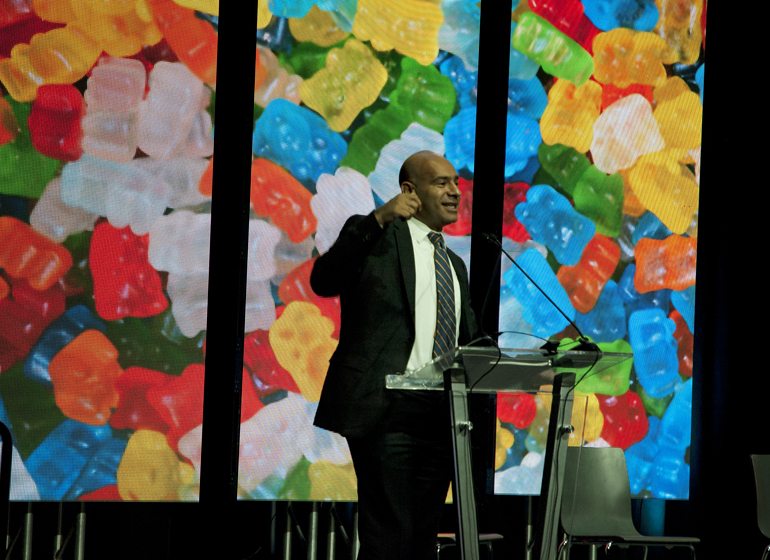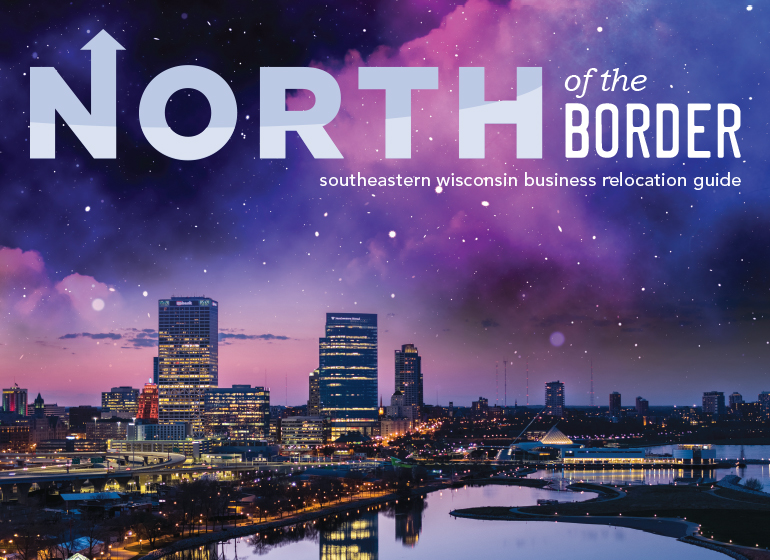1. Amazon to build massive Oak Creek facility
When the world’s largest online retailer opened a 1.5 million-square-foot fulfillment center in Kenosha in 2015, few would’ve expected that less than five years later, it would be the company’s second largest development in southeastern Wisconsin.
Seattle-based e-commerce giant Amazon is building a 2.6 million-square-foot, $200 million facility in the Ryan Business Park near I-94 in the southern Milwaukee County suburb of Oak Creek.
“The Amazon development in Oak Creek will be the largest industrial building in the state of Wisconsin,” said real estate broker Jim Barry III, president at Milwaukee-based The Barry Co.
The new four-story facility is expected to employ 1,500 people by the end of 2021. And important for those future employees is Amazon’s October announcement that it would raise its minimum wage to $15 per hour for U.S employees.
Amazon has said the new project won’t conflict with its operations in Kenosha just 18 miles away, but instead is an example of Amazon “investing where it makes sense to get us closer to the customer” with the goal of improving delivery service in the Milwaukee metro area, said Amazon spokeswoman Brenda Alfred.
The project was approved by the Oak Creek Common Council in late November. The City of Oak Creek’s deal included a $16.9 million tax increment financing agreement with the city. As part of the agreement, Amazon committed to an investment of at least $200 million, consisting of $100 million of real property improvements and $100 million of personal property installed in the facility.
The 75-acre Amazon site will be developed and owned by an affiliate of Dallas-based Hillwood Development Co. LLC. It’s part of the Ryan Business Park, which is being developed by Waukesha-based Capstone Quadrangle and Fox Point-based General Capital Group. Part of the city’s deal calls for Hillwood to fund $13.4 million in infrastructure costs for improvements on South 13th Street and Ryan Road.
Construction for the project is already underway and completion of the building is set for the first quarter of 2020.

2. Foxconn project continues, with changes

There’s no denying that the massive Foxconn Technology Group project will be transformational. But less than two years after the megadeal was approved, southeastern Wisconsin is looking at a much different future for the project than was originally envisioned.
The “Wisconn Valley” project that would include a $10 billion capital investment intended to bring up to 13,000 permanent jobs to the Village of Mount Pleasant, aided by more than $4 billion in taxpayer dollars, has already changed dramatically.
Originally intended to be anchored by a factory producing generation 10.5 LCD screens, Foxconn now plans to build smaller Gen 6 LCD screens. Reports in late January from Reuters and Nikkei Asian Review cast doubt on whether or not that factory would even be built, but the Taiwanese electronics giant reversed course days later following talks with the White House, saying that it would move forward with these modified plans. A Bloomberg Businessweek cover story that followed also extensively detailed widespread problems on multiple levels with the Foxconn project.
Hiring, too, changed significantly from original plans. Foxconn fell short of its 2018 hiring goal, creating just 178 of the 260 jobs required for the company to receive any state tax credits, and the 1,040 jobs needed to earn all available credits. It was also revealed that Foxconn can earn tax credits from Wisconsin on work being done outside the state.
Construction in Mount Pleasant, however, continues. The project’s first new building was recently completed. Plans for the next 18 months include construction of a liquid crystal module backend packaging plant; a high-precision molding factory; a system integration assembly facility; centers for rapid prototyping, research and development, and data; and a town center.
Foxconn also made a $100 million gift to the University of Wisconsin-Madison and spent more than $37 million on buildings for innovation centers in Milwaukee, Green Bay, Eau Claire and Racine. In Milwaukee, the company has a significant presence after purchasing a seven story, 132,000-square-foot office building for $11.5 million to be its North American headquarters.
Company spokeswoman Myranda Tanck said a more extensive update to the construction timeline and review of progress is coming later in the spring, following an annual companywide reevaluation.
3. Several new health care facilities planned
Often overlooked players in the world of real estate development are health care providers, but some of the larger projects announced this year came from the region’s growing and changing health systems.
The biggest project from a health provider in southeastern Wisconsin over the past year has been Advocate Aurora Health’s $241 million of planned development, spread over three different locations in Racine County. The most substantial of the three, a $228 million medical center and medical office building, is set to be located in Mount Pleasant. A $13 million new Mount Pleasant clinic will break ground this spring, and a third Racine County development is yet to be announced, Advocate Aurora said.
“Growth in the Racine County corridor provides an immediate opportunity for Advocate Aurora Health to accelerate our population health efforts to deliver greater value for the communities and employers we are privileged to serve,” said Jim Skogsbergh, president and chief executive officer of Advocate Aurora Health, at the time of the announcement.
The Milwaukee and Downers Grove, Illinois-based health system announced the project just weeks after finalizing its merger.
Aurora also announced last year that it would build a $130 million facility that includes a 100,000-square-foot ambulatory surgery center and 100,000-square foot medical office building just north of the Illinois-Wisconsin border in the Village of Pleasant Prairie. It is set to open in summer 2020.
Children’s Hospital of Wisconsin is also expanding in Wauwatosa, with a six-story, 237,000-square-foot building addition. The health system is investing $265 million in the project over the next four years. It will also expand its emergency department and trauma center. Construction is beginning in early 2019, with targeted completion in 2022.
Just around the corner, the Medical College of Wisconsin’s Wauwatosa campus will be undergoing a $43 million renovation of its oldest research building through 2021.
Froedtert & the Medical College of Wisconsin also recently announced plans for two smaller scale “neighborhood hospital” developments in the region, in Mequon and Oak Creek.

Credit: Zimmerman Architectural Studios
4. Haribo project to begin this year

Southeastern Wisconsin will soon get just a little bit sweeter when Haribo starts work at its new gummy bear factory in Pleasant Prairie.
The Germany-based company in 2017 chose Wisconsin for its first production operation in North America. The $242 million project will be reshaping the area two miles north of the Wisconsin-Illinois border for years to come.
The company purchased more than 130 acres of land in the Prairie Highlands Corporate Park to build its 500,000-square-foot production facility that will eventually employ nearly 400 people.
The North American subsidiary of Haribo, Rosemont, Illinois-based Haribo of America, is America’s fastest-growing confectionary company, and it has been excited about getting started in Wisconsin.
“We are overjoyed with the warm welcome we’ve received from the people of Wisconsin,” said Lauren Triffler, spokeswoman for Haribo. “We’re focused on building a best-in-class facility and strong team to support this growth initiative, and are passionate about bringing confectionery manufacturing jobs to our new home in the Midwest.”
That best-in-class facility is set to have its official groundbreaking later this year, with construction set to begin thereafter. Construction, initially expected to be completed in 2020, will extend “a bit beyond 2020,” said Triffler, to prioritize quality and account for winter breaks.
The Haribo project has been aided by $21 million in tax credits from the Wisconsin Economic Development Corp. As part of the agreement, the company is required to create jobs, make capital investments, invest in job training, and use other Wisconsin companies as suppliers.
Haribo recently welcomed officials from the Village of Pleasant Prairie to tour its operations at two production facilities in Germany.
The company chose the Pleasant Prairie site over seven locations in the state of Illinois and one other option in Kenosha County, according to state records.
5. Big developments coming to Harbor District

Credit: Zimmerman Architectural Studios
Seemingly overnight, Milwaukee’s “Harbor District,” the long-dormant area along Lake Michigan south of the Historic Third Ward, has gone from little more than an idea to one of the region’s most active spots for development.
Two major catalytic projects from businesses with deep Wisconsin roots began to take shape over the past year, injecting new life into the area in a big way.
Brownsville-based construction firm Michels Corp. announced a $100 million mixed-used development, and Japanese heavy equipment manufacturer Komatsu Mining Corp., which acquired Milwaukee-based Joy Global Inc. in 2017, will build a brand new $285 million headquarters and manufacturing campus that will anchor its North American operations in the Harbor District.
Matthew Beaudry, project director and general manager of Komatsu’s new “South Harbor” campus, said the company could have gone anywhere and did look at other locations, but chose to stay in Milwaukee.
“We’re really excited about the redevelopment opportunity here,” he said. “We really wanted to stay in this area because of our long history in Milwaukee and the close connection that we have and continue to have in this community.”
Komatsu will be moving from its West Milwaukee location near Miller Park, bringing about 600 employees, which will grow to about 1,000 employees after the new campus opens in 2022. The site was formerly occupied by Solvay Coke and the redevelopment was supported by the City of Milwaukee, which is providing assistance to the project through a tax increment financing district, as well as by the Wisconsin Economic Development Corp., which is providing $59.5 million in state income tax credits.
Michels’ development, along the banks of the Kinnickinnic River, will include an eight-story office building with 220,000 square feet of space, a 67-unit apartment building, 19,000 square feet of retail, a 103-room hotel, and nearly 1,000 underground parking spaces over six acres.
The development held its groundbreaking in December 2018, is expected to be out of the ground by August 2019, and the goal is for the first building of the multi-phase project to be finished in June 2020, said David Stegeman, chief legal officer and senior vice president at Michels, who added that 250 new jobs are expected to be added over the next few years at that location.
“The Harbor District is cooking; there’s no doubt about it,” Stegeman said. “The critical anchor presence of Komatsu, Rockwell (Automation) and Michels are certainly going to be energizing to the area.”


